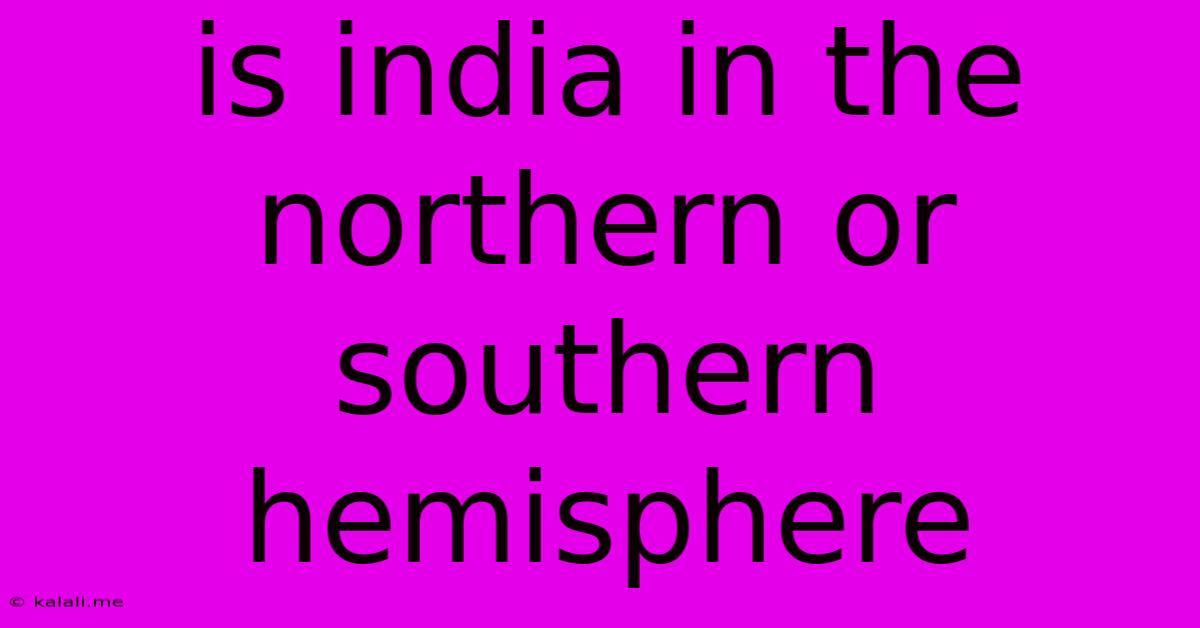Is India In The Northern Or Southern Hemisphere
Kalali
Jun 13, 2025 · 3 min read

Table of Contents
Is India in the Northern or Southern Hemisphere? A Geographical Exploration
Meta Description: Discover the geographical location of India. Learn whether it's situated in the Northern or Southern Hemisphere, and explore its climatic zones and unique geographical features.
India, a land of vibrant cultures and diverse landscapes, is situated primarily in the Northern Hemisphere. While a tiny sliver of its southernmost tip might technically touch the equator, the vast majority of the country lies north of the imaginary line that divides the Earth. This geographical placement significantly influences its climate, biodiversity, and overall environment.
Understanding Hemispheres
Before diving into India's specific location, let's quickly recap what defines the Northern and Southern Hemispheres. The Earth is divided into two halves by the equator, an imaginary line circling the globe at 0 degrees latitude. Areas located north of the equator are in the Northern Hemisphere, while those south of the equator are in the Southern Hemisphere.
India's Position and its Implications
The majority of India's landmass is comfortably nestled within the Northern Hemisphere. This positioning has considerable impact on:
-
Climate: India experiences a diverse range of climates, primarily influenced by its location in the Northern Hemisphere. The country experiences distinct seasons, including a hot, dry summer, a monsoon season with heavy rainfall, and a relatively cool winter. This is typical of regions in the Northern Hemisphere's tropical and subtropical zones.
-
Seasons: The timing of seasons aligns with the Northern Hemisphere's seasonal calendar. Summer occurs during the Northern Hemisphere's summer solstice (around June), while winter coincides with the winter solstice (around December).
-
Daylight Hours: The duration of daylight hours throughout the year follows the pattern of the Northern Hemisphere, with longer days in summer and shorter days in winter.
-
Biodiversity: India's geographical location in the Northern Hemisphere contributes to its immense biodiversity. The country's varied climates and landscapes support a vast array of plant and animal life, reflecting its position within several biomes specific to the Northern Hemisphere.
Beyond the Basics: Geographical Features and Subregions
While the primary geographical positioning of India is in the Northern Hemisphere, it's crucial to understand its diverse geographical features. These include:
-
The Himalayas: The towering Himalayan mountain range forms a natural northern border, creating a distinct geographical and climatic zone.
-
The Indo-Gangetic Plain: This fertile plain stretches across northern India, supporting a large population and intensive agriculture.
-
The Deccan Plateau: A vast plateau in southern India, contributing to the region's unique topography and climate.
-
Coastal Regions: India boasts extensive coastal regions, both on the east and west coasts, influenced by the Bay of Bengal and the Arabian Sea, respectively.
In Conclusion
To answer the question directly: India is predominantly located in the Northern Hemisphere. Its position significantly shapes its climate, seasons, biodiversity, and overall geographical character, contributing to the rich tapestry of landscapes and cultures that define this remarkable nation. Understanding this fundamental geographical aspect is essential for comprehending India's diverse environment and its profound influence on its people and their history.
Latest Posts
Latest Posts
-
Select The Correct Statement Regarding Chemical Synapses
Jun 14, 2025
-
Shortcut For Wrap Text In Excel
Jun 14, 2025
-
Which Of The Following Are Good Conductors
Jun 14, 2025
-
If F 1 1 What Is F 3
Jun 14, 2025
-
How Many Distinct 5 Digit Numbers Can Be Formed
Jun 14, 2025
Related Post
Thank you for visiting our website which covers about Is India In The Northern Or Southern Hemisphere . We hope the information provided has been useful to you. Feel free to contact us if you have any questions or need further assistance. See you next time and don't miss to bookmark.